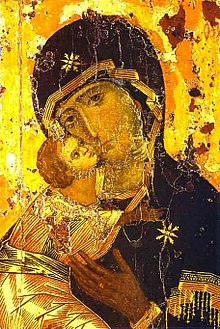
Back دوام عذرية مريم Arabic دوام عذرية مريم ARZ Věčné panenství Panny Marie Czech Immerwährende Jungfräulichkeit Marias German Αειπάρθενο της Θεοτόκου Greek Ĉiama virgeco de Maria Esperanto Virginidad perpetua de María Spanish Virginité perpétuelle de Marie French הבתולים הנצחיים של מרים HE Trajno djevičanstvo Djevice Marije Croatian

The perpetual virginity of Mary is a Christian doctrine that Mary, the mother of Jesus, was a virgin "before, during and after" the birth of Christ.[2] In Western Christianity, the Catholic Church adheres to the doctrine, as do some Lutherans, Anglicans, Reformed, and other Protestants.[3][4][5][6][7] In Eastern Christianity, the Oriental Orthodox Churches and the Church of the East both adhere to this doctrine as part of their ongoing tradition,[8][9] and Eastern Orthodox churches recognize Mary as Aeiparthenos, meaning "ever-virgin".[10] It is one of the four Marian dogmas of the Catholic Church.[11] Most modern nonconformist Protestants reject the doctrine.[12]
The extant written tradition of the perpetual virginity of Mary first appears in a late 2nd-century text called the Protoevangelium of James.[13] The Second Council of Constantinople in 553 gave her the title "Aeiparthenos", meaning Perpetual Virgin, and at the Lateran Synod of 649 Pope Martin I emphasized the threefold character of the perpetual virginity, before, during, and after the birth of Christ.[14] The Lutheran Smalcald Articles (1537) and the Reformed Second Helvetic Confession (1562) codified the doctrine of perpetual virginity of Mary as well.[15][3]
The doctrine of Mary's perpetual virginity has been challenged on the basis that the New Testament explicitly affirms her virginity only until the birth of Jesus[16] and mentions the brothers (adelphoi) of Jesus,[17][18] who may have been: (1) sons of Mary, the mother of Jesus, and Joseph; (2) sons of Joseph by a former marriage; or (3) sons of the Mary named in Mark 15:40 as "mother of James and Joses", who has been identified as either the wife of Clopas and sister of Mary, the mother of Jesus, or a sister-in-law to Joseph.[19][a]
- ^ Hesemann 2016, p. unpaginated.
- ^ Bromiley 1995, p. 269.
- ^ a b "THE SECOND HELVETIC CONFESSION". www.ccel.org. Retrieved 2021-12-21.
- ^ Alexander, Joseph Addison (1863). The Gospel According to Mark. C. Scribner.
- ^ The American Lutheran, Volume 49. American Lutheran Publicity Bureau. 1966. p. 16.
While the perpetual virginity of Mary is held as a pious opinion by many Lutheran confessors, it is not regarded as binding teaching of the Scriptures.
- ^ The New Encyclopaedia Britannica, Volume 11. Encyclopaedia Britannica. 1983. p. 562. ISBN 978-0-85229-400-0.
Partly because of these biblical problems, the doctrine of the perpetual virginity of Mary has not been supported as unanimously as has the doctrine of the virginal conception or title mother of God. It achieved dogmatic status, however, at the Council of Chalcedon in 451 and is, therefore, binding upon Eastern Orthodox and Roman Catholic believers; in addition, it is maintained by many Anglican, some Lutheran, and a few other Protestant theologians.
- ^ Losch 2008, p. 283.
- ^ "The Perpetual Virginity of St. Mary". ninesaintsethiopianorthodoxmonastery.org. Retrieved 2024-02-05.
- ^ Toma, George (2022). Mary in the Tradition of the Church of the East/in the Syriac Tradition (PDF). pp. 1, 26, 96–97.
- ^ Fairbairn 2002, p. 100.
- ^ Collinge 2012, p. 133.
- ^ Campbell 1996, p. 150.
- ^ Lohse 1966, p. 200.
- ^ Polcar 2016, p. 186.
- ^ Gill 2004, p. 1254.
- ^ Matthew 1:25
- ^ Maunder 2019, p. 28.
- ^ Parmentier 1999, p. 550.
- ^ Cross & Livingstone 2005, p. 237-238.
Cite error: There are <ref group=lower-alpha> tags or {{efn}} templates on this page, but the references will not show without a {{reflist|group=lower-alpha}} template or {{notelist}} template (see the help page).